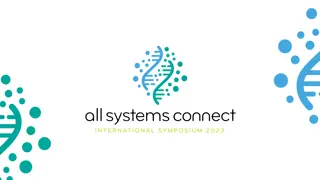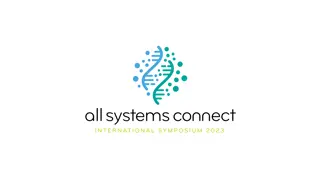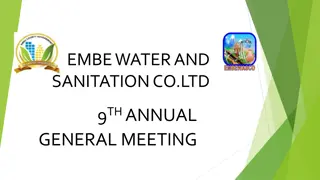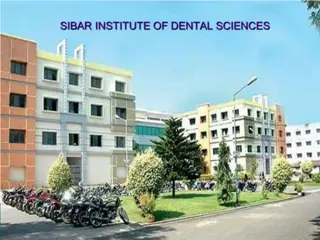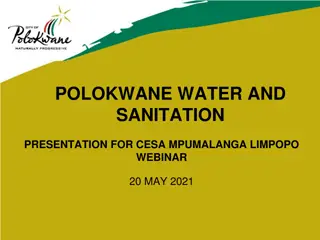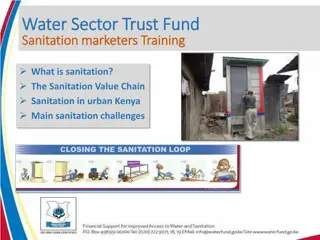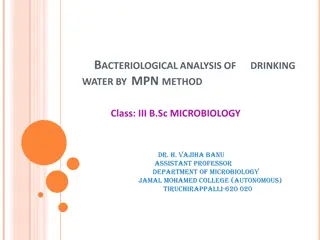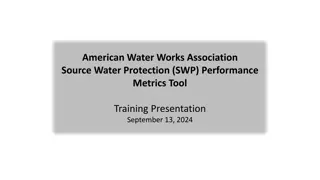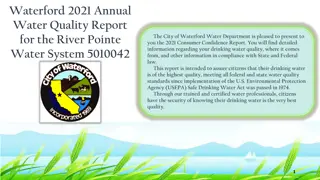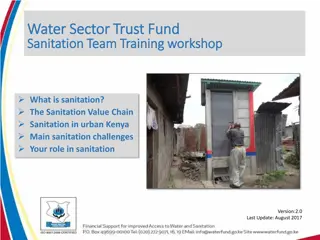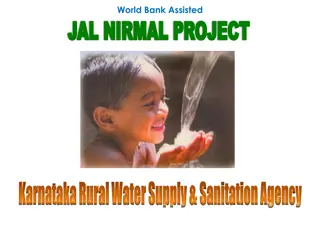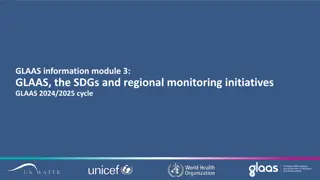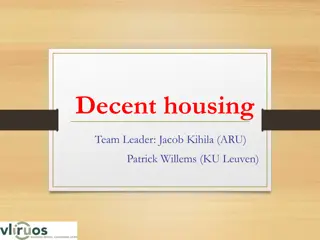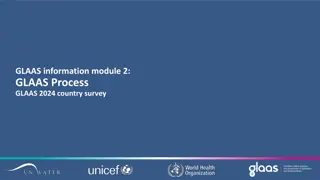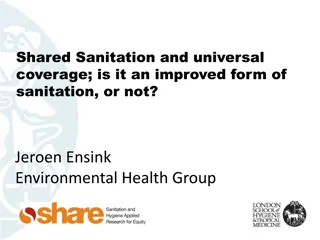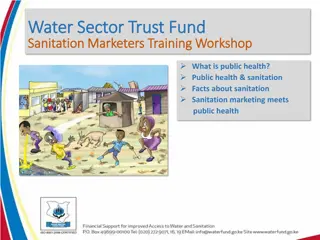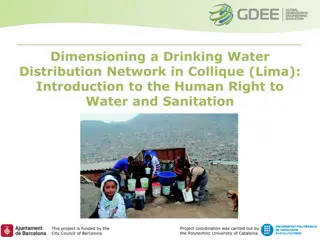Overview of GLAAS: Global Assessment of Sanitation and Drinking Water
GLAAS, implemented by WHO and UNICEF on behalf of UN-Water, provides global updates on WASH systems. It focuses on monitoring, identifying progress drivers, and supporting country-led processes. The data collected helps in improving sector coordination, developing policies, and advocating for funding. Countries have utilized GLAAS data to enhance their WASH systems and contribute to achieving SDGs.
Download Presentation

Please find below an Image/Link to download the presentation.
The content on the website is provided AS IS for your information and personal use only. It may not be sold, licensed, or shared on other websites without obtaining consent from the author.If you encounter any issues during the download, it is possible that the publisher has removed the file from their server.
You are allowed to download the files provided on this website for personal or commercial use, subject to the condition that they are used lawfully. All files are the property of their respective owners.
The content on the website is provided AS IS for your information and personal use only. It may not be sold, licensed, or shared on other websites without obtaining consent from the author.
E N D
Presentation Transcript
GLAAS information module 1: Introduction to GLAAS GLAAS 2024/2025 cycle
What is GLAAS? GLAAS: UN-Water Global Analysis and Assessment of Sanitation and Drinking-Water Implemented by the World Health Organization in collaboration with UNICEF on behalf of UN-Water. A global update on WASH systems, including policy frameworks, institutional arrangements, monitoring systems, regulation, human resources and finance.
GLAAS areas of work WASH accounts using the TrackFin methodology SDG monitoring UN- Water GLAAS GLAAS data collection, reports and data portal Collaboration and partnerships
GLAAS data collection and reports: Purpose and objectives Monitor the inputs required to extend and sustain WASH systems and services to all, especially unserved and disadvantaged groups Support country-led processes that bring together the many institutions and actors that are involved in WASH Identify drivers and bottlenecks of progress, highlight knowledge gaps and assess strengths and challenges across countries Analyze and highlight data from countries and development partners in reports, highlights and on the GLAAS data portal
Benefits of GLAAS to Countries Provides a useful situation analysis of WASH systems Identifies information gaps Helps decision-makers define priorities and devise plans Brings different stakeholders together Contributes to SDG monitoring and regional monitoring initiatives Countries have reported that the GLAAS process and data collected through GLAAS have contributed to: Improved sector coordination Development of policies and plans/strategies Stronger national monitoring and review systems Advocacy for funding/financing International and regional reporting
Examples of countries using data from the GLAAS process In Azerbaijan, data collected through GLAAS contributed to the development of a national drinking-water quality standard. In Bangladesh, data from the GLAAS survey were used in developing strategic WASH documents such as the National Strategy for Water supply and Sanitation 2021. In Ecuador, based on the information obtained, proposals for guidelines and technical instruments aimed at strengthening WASH in the country were prepared. In Fiji, data generated through the GLAAS process is used for monitoring progress towards the Sustainable Development Goals and the National Development Plan In Guinea, the GLAAS process created an opportunity to advocate for a budget line from the government for financing rural sanitation. In Tunisia, GLAAS results along with other national monitoring data highlighted a critical policy gap for regulating WASH in schools.
GLAAS 2024/2025 cycle - Updates Updates to the GLAAS 2024 country survey: New questions on climate resilient WASH New questions on human resources New monitoring questions on national indicators and management information systems Streamlined and refined survey guidance document Outlines the GLAAS process and general survey instructions Provides additional information on some key questions eGLAAS: The online version of the GLAAS country survey package is available in English, French and Spanish More information on eGLAAS can be found in Module 4 as well as in the GLAAS country survey guidance To complete the GLAAS 2024 country survey using eGLAAS, please contact glaas@who.int Data portal: All data from the GLAAS 2024 country survey will be available on the GLAAS data portal, including country highlights for the GLAAS 2024/2025 cycle.
GLAAS 2024/2025 cycle timeline Country highlights on the GLAAS data portal Country survey available April 2024 GLAAS 2025 report and data available on the GLAAS data portal Final deadline for GLAAS country survey: 15 October 2024 2024 2025 Apr Jun Aug Oct Dec Data management including quality assurance Regional GLAAS trainings Use of GLAAS data in country processes & SDG reporting
GLAAS data portal Allows users to interactively explore and download datasets by topic area and visualize key indicators. Includes data collected through GLAAS since the 2013/2014 cycle, allowing for trend analyses. Possible to analyse data at the global, regional or country level. Data from the GLAAS 2024 country survey will be featured on the GLAAS data portal as GLAAS country highlights. Countries will have the opportunity to review their country highlights on the GLAAS data portal before they are published. Visit the GLAAS data portal at: https://glaas.who.int
UN-Water GLAAS 2025 Report Information collected through the GLAAS country survey will be presented in the UN-Water GLAAS 2025 report as well as featured on the GLAAS data portal. The GLAAS 2025 Report is expected in Q3 2025. The GLAAS 2022 Report
Thank you! For additional information please contact glaas@who.int



